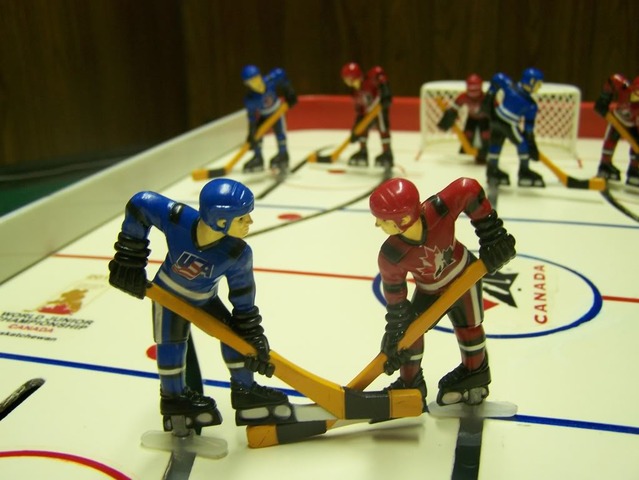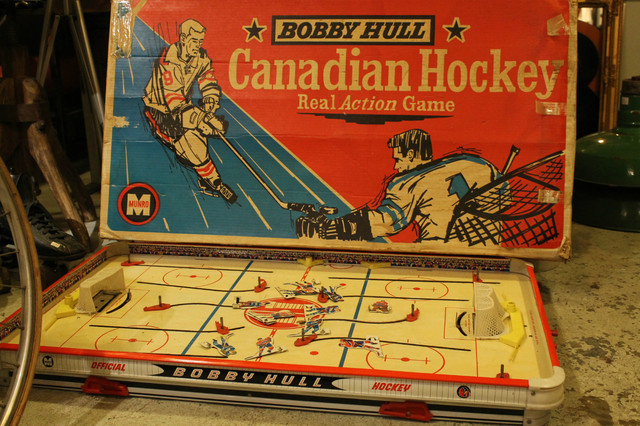TABLE/ROD HOCKEY
Table Hockey, also called Rod Hockey, Stick Hockey, Bubble Hockey, and Board Hockey, is a game for two players, derived from ice Hockey. The game consists of a representation of a Hockey rink; the players score goals by hitting a small puck into the opposing "net" with plastic or metal figures that represent Hockey players. The figures are manipulated by rods below / underneath the table Hockey game: each one slides forward and back along its own narrow slot when the player pushes or pulls on the rod, or rotates (about a vertical axis) to shoot or stickhandle the puck when the player spins the rod.
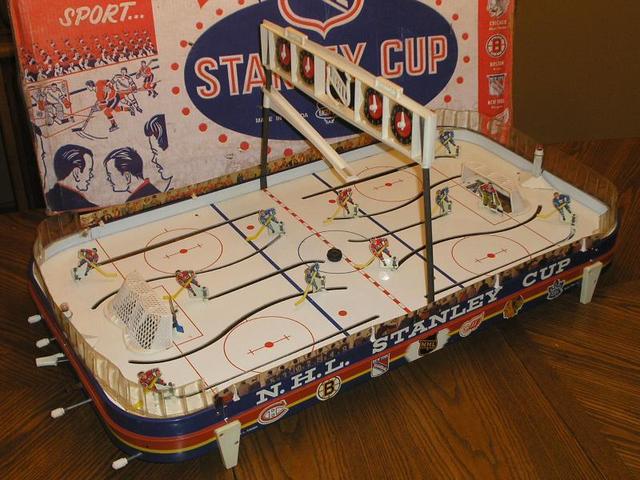
Table Hockey is also a sport played on table hockey games. The International Table Hockey Federation - ITHF uses only table Hockeys made by Stiga. The origin of the sport was the Swedish Championship 1982 in Upplands Väsby, won by Göran Agdur. Organized table hockey is played in Northern, Central and Eastern Europe, North America and in Japan.
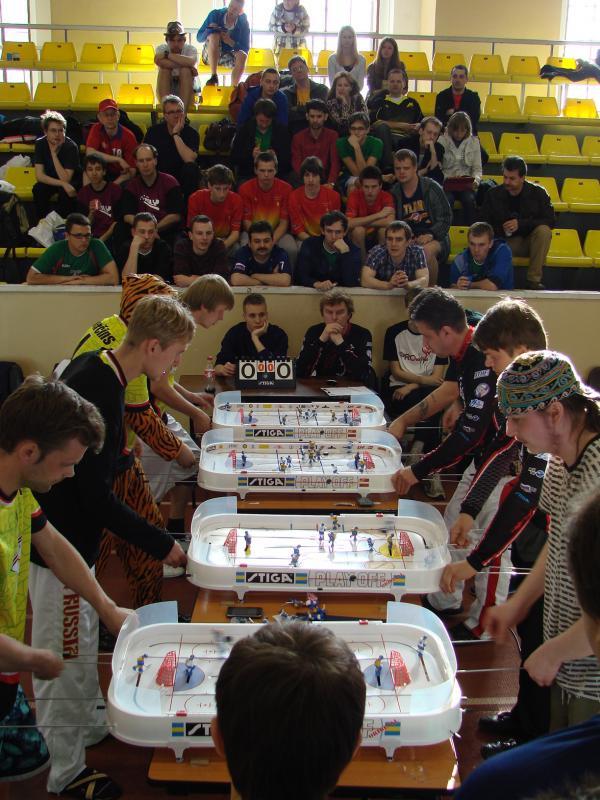
The World Championship is organized by the ITHF every two years. The Stiga Play Off game is the official game of the Table Hockey World Championship.
Sweden has dominated the table hockey scene from the beginning and a couple of years into the new millennium. Until the Finnish gold in Riga 2005, Sweden had won all Team World Championships, until 2006 only Swedes had won the Open Swedish Masters, and until 2007 all individual world champions were Swedes. But the new generation comes from Finland, Russia, the Czech Republic and Latvia.
The ITHF divides individual tournaments to six levels. The first level tournaments are: World Championships, World Junior Championships, World Women Championships and World Senior Championships. Tournaments on the second level are European Championships, European Junior Championships, European Women Championships and European Senior Championships and Big Six tournaments. The third level tournaments are the World Tour (former EuroLeague) tournaments. The fourth level contains mostly country series (e.g. Český pohár (en Czech cup)). The fifth and sixth level includes regional and city series and tournaments organized by clubs. Special Level 10 is for club tournaments, such as World Club Championships.
In 2003/04, the first world wide league, EuroLeague, was created. 6 tournaments formed the league, The tournaments were Helsinki Open, Oslo Open, Riga Cup, Swedish Masters, Moscow Open and Czech Open.
The league has changed name to World Table Hockey Tour, and consists every year of around 15 tournaments. The original 6 tournaments are still regarded as the most important tournaments, and are called the Big Six tournaments.
The World ranking sorts players by their actual rank points. The ranking is sum of player's best results in last two years. Points, which player gets for participating in any reported tournament are counted on the basis of: level of the tournament, number of players beaten and world ranking of players beaten. A winner of the World Championship gets always 1000 points and a winner of World Junior, Veteran or Women Championship gets at least 500 points.

HISTORY
Table Hockey was invented in 1932, in Toronto by the Canadian Donald H. Munro Sr. Don, like so many Canadians in the depths of the depression, was short of cash for Christmas presents. He had a wife and three young children. That year, the family all pitched in and made the first table Hockey game. This mechanical game was built out of scrap wood and metal, and included used coat hanger wire, butcher's twine clock springs and the lumber came from the coal bin. The game looked more like an early pinball game, with one key difference: this was a two player game. The playing surface had a peak in the middle and sloped down toward each end. The players controlled levers for the goalie and flippers for the players. The story goes that a travelling salesman noticed the game and encouraged Don to take the game down to the local Eaton's department store. Soon after, Munro built a handful of these games on consignment for the Eaton's department store in Toronto. They turned out to be an instant success.
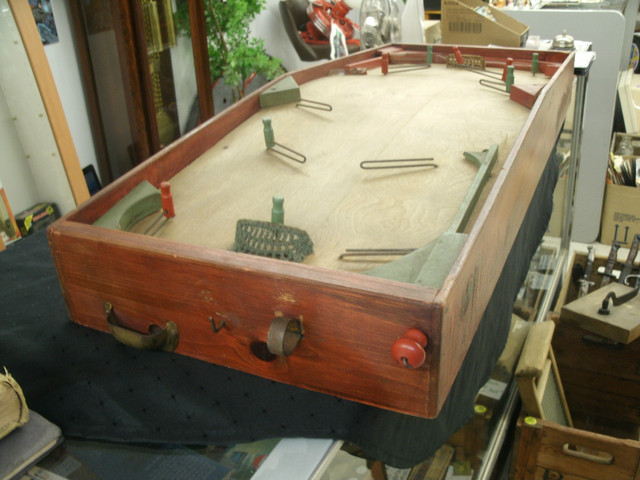
Table Hockey style games had also been played using a variety of commercial boards in North America since the 1920s.

Due to their size (about 14 by 36 inches), the early Munro wooden game were sold mainly in department stores and through mail order catalogs, though occasionally they would be earned in sporting goods and hardware stores. The games sold for between four and five dollars during the 1930s. The first recorded price was listed in the 1939-40 Eaton's Fall & Winter Catalogue where the Munro Standard Model was advertised for $4.95.
These early games, referred to as "the wooden game" by collectors, were produced every year until 1955. During this period of 22 years, many improvements were made in the playing quality and appearance. Despite these many improvements, the early wooden Hockey games bore only a passing resemblance to the on-ice game. Players, for example, were simply wooden pegs with wire loops that moved back and forth like pinball flippers. Still, these games were exceedingly popular. One of the main reasons for this popularity was the design of the hump or high area in the center of the playing surface. This innovation allowed the puck (actually a metal ball) to roll to either end of the game and made it possible for both players to be actively involved at the same time (one on offense and one on defense). Until this time, bagatelle games (and even modem day pinball games) all were played on a single slope enabling only one player at a time to participate.
The number of games produced in these early days would range from a few hundred to a few thousand. In the 1940s, the Munro Standard Model was expanded to include a deluxe version where the ball would roll out of the net after a goal and into a small cup mounted at each end of the game. A Club Model, with a heavier wooden frame and stronger wire parts, was introduced for the many Boys Clubs that existed in Canada at this time.
In 1945-46, Munro's partner, Stewart Molson Robertson, manufactured games in Rochester, New York under Munro's American patent, but despite the popularity of the games in Canada, the venture proved unsuccessful in the United States. Sales in Canada were increasing to several thousand games per year, and by 1954, the last full year in which these wooden games were made, prices were $8.95 for the Standard Game, $10.95 for the Deluxe and $ 14.95 for the Club. The Deluxe was by far the most popular model.
During the era of the wooden game, three different mechanical Hockey games surfaced. The first was built by Gotham Pressed Metal Products of The Bronx, New York City, who displayed their version of "Ice Hockey" in their 1937 catalog. Like the Munro game, Gotham's playing surface featured a hump in the center to keep the puck (again a metal ball) moving from side to side. However, the Gotham game featured only one player at either end who both guarded the goal and pivoted in a complete circle to shoot the puck into the other end. A second competitor to Munro was introduced by the Reliable Toy Company of Toronto in 1953. Patterned after the Munro Game, the "Foster Hewitt Hockey Game" was made of plastic and came equipped with figures shaped like miniature Hockey players molded out of die-cast metal. The game was comparatively small (approximately) 12" x 24") and was sold for only a few years before being replaced by the more modem-style games.
The first of these modem-style games (and the challenger that finally ended Munro's wooden era) was introduced by the Eagle Toy Company of Montreal in 1954. Eagle's National Hockey Game was endorsed by the Montreal Canadiens and was an immediate success for several reasons. It was the first Canadian game to feature players printed in color on flat tin cutouts shaped like real hockey players who stood on a surface that resembled ice. Eagle's game was decorated with team pennants from the NHL and was the first Canadian game to feature metal rods that allowed its players to pivot a complete 360 degrees. The Eagle game measured 16" x 36" and sold for $10.95. Soon, both Munro and Eagle were issuing similar games that not only had rods to allow the players to spin but also had slots that let them slide up and down the ice surface.
The innovation that led to metal rods and slots had actually been patented in Sweden in 1937 by Bernt Unger. Aristospel A.B. of Stockholm manufactured the game starting in 1938, which was sold to several European countries. A Canadian patent was issued in 1941, but although the design of the Swedish game was unique at the time, it was a difficult and costly game to manufacture. In 1972, Aristospel A.B. went bankrupt following 34 tough seasons with its table Hockey game.
At the beginning of the 60s another games company, Alga, also started to manufacturer table Hockey games. Alga's game was more refined, and had both round corners and higher sideboards. The game was also the first one to feature three-dimensional figures. Another new addition was the fact that the right winger (but not the left winger) was able to play behind the goal. However, after only two years, Alga stopped manufacturing the game because of major quality defects.
Not until 1954 would a Canadian company (Cresta Limited of Toronto) introduce and manufacture the Swedish-style game. Also in 1954, K & B Toys of Burlington, Ontario copied the Cresta game and issued their own version under the name "3 Star Hockey." K & B was only in business until 1957, while Cresta lasted until 1958. Neither proved able to compete with Eagle and Munro, who had both unveiled their own rod-and-slot hockey games at the Montreal Toy Show in January of 1956. From that point on, Munro and Eagle produced nearly all of the Hockey games sold in Canada and the United States.
The most popular board for many years was manufactured by the now-defunct Coleco company, and most North American boards such as those built by The Carrom Company and Irwin Toys are a variant of this model.
Over the years, Munro and Eagle were the undisputed leaders in designing and creating models that year after year became more realistic in their appearance. The games also played better through such innovations as goal lights, period timers, puck droppers, and "glass" above the boards. Three-dimensional players were first introduced by Munro back in 964, and while both Munro and Eagle experiment with the design of their players, the flat tin men remained the most popular. In 1971, safety concerns forced a switch to plastic men with self-adhesive team labels that customers applied themselves. Eagle's games had the official endorsement of the NHL and could replicate exactly the uniforms of its teams.
Munro relied on the endorsement of top stars like Bobby Orr and Bobby Hull for their games and could only approximate the NHL uniforms. The televising of NHL games during the 1950s and the league's expansion in 1967 greatly enlarged the North American market for table top Hockey games. Whereas thousands of games had been sold previously, the numbers were now beginning to reach the hundreds of thousands and were climbing every year. To meet the rising demand, both Munro Games and Eagle Toys were sold to U.S. companies in September of 1968-Munro to Servotronics and Eagle to Coleco. Their dominance of the Canadian and American markets would continue-with games growing larger (24" x 34") and prices ranging up to 30 and 40 dollars during the 1970s.
Usage of plastic brought in expansion of table Hockey. The Swedish company Stiga started to make table Hockey games in the 1980s.
By the late 1980s, a resurgence of table Hockey occurred with lrwin Toys acquiring Coleco's tooling and companies like Stiga, Playtoy/Rernco, Radio Shack, and Kevin Sports developing new games in North America. A Wayne Gretzky-endorsed game was introduced by Kevin Sports in 1990, selling for $120
Worldwide development arrived in the late 1990s. That lead to an idea founding an international federation. ITHF - International Table Hockey Federation was established during the World Championship 2005 in Riga, Latvia. Now it associates sixteen national federations.
